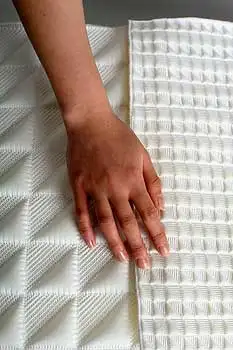
Textile design student Jessica Bunnell and the range of fabrics she has created with therapeutic benefits for people with ADHD. Her design is part of the Exposure Exhibition on at the College of Creative Arts, Massey University, Wellington, till November.
Textile design student Jessica Bunnell has created a range of fabrics with possible therapeutic benefits for people affected by Attention Deficit Hyperactivity Disorder.
Known as ADHD, the disorder is characterised by a person’s inability to concentrate for long periods and have a compulsive need to fidget or have difficulty controlling their behaviour.
Recognising the powerful sense of touch, Ms Bunnell realised the tactile qualities of most textiles could help create a calming effect for ADHD sufferers. Other research undertaken for her final year project showed such textiles could also help increase the attention span of a person with ADHD and help them remember information better.
Her range of conceptual textiles are part of the Exposure Exhibition of work of final-year art and design students from Massey University’s College of Creative Arts.
“Everyone experiences textiles in a different way so I was keen to use a range of scales to create different effects,” she says.
The eight textile varieties she has created range between variations of 3D embroidery to silicone ridges, silicone and knit and embroidery on foam – the latter using digital embroidery made with foam to create a raised quilted-like surface.
“I’ve always been interested in tactile textiles. I have been drawn into the way it makes the user want to interact with the material,” she says. “I’ve always been interested in using innovative materials such as silicone to create unusual textures and want to make textiles therapeutic for an audience.”

For her research, she spoke to a teacher who taught children with autism and ADHD. According to estimates by the American Psychiatric Association the latter condition can affect between three and seven per cent of all children.
While there were already lots of objects known as fidget toys available, few had what she refers to as “surfaces of individuality” to accommodate the needs of older ADHD sufferers.
“Fidget toys are very bright to appeal to children but ADHD can affect adults too so I wanted a more sophisticated look.”
Her designs were also influenced by research from paediatric occupational therapist Lisa Kurtz into two types of sensory stimulus from a particular sense- in this case touch. Energising input, with qualities that include a gentle light touch, soft textures and tickling; and a calming input characterised by firm touches and strokes, hugging and other stroking and moving of hands.
Ms Bunnell created an all-white colour palette so her fabrics didn’t detract from the textile and was more tactilely engaging.
She is keen to use more colour in her designs in the future and while it still needed to be user tested, she believes such textiles could be applied to the arms of a chair or the linings of jacket pockets to help deter and soothe any fidgeting impulse.
Her designs won a textile design for embroidery award and an excellence in textile design award from uniform and corporate clothing manufacturer Booker-Spalding.